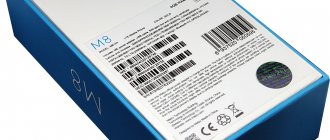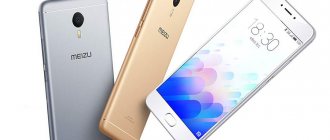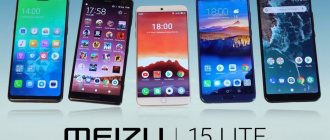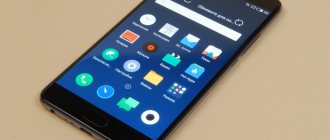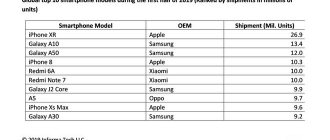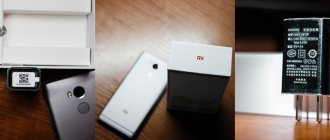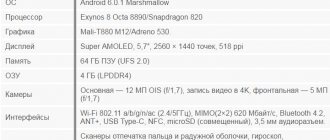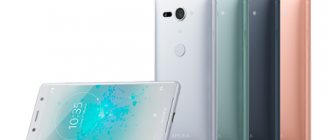The company held a presentation of Meizu smartphones, among which was the M5 Note - a continuation of one of the most popular Meizu smartphones, the M3 Note. The absence of a fourth version is explained by the fact that among the Chinese the number 4 is considered unlucky, so the new product immediately received the 5th number.
Looking ahead, we will say that in terms of characteristics the device is an almost complete copy of the M3e, and differs, by and large, only in the increased screen diagonal. Is this good or bad? Read our review of Meizu M5 Note.
Equipment and appearance
Traditionally, for all Meizu devices, the smartphone comes in a simple white box made of thick cardboard; the package also includes a USB cable, a charging adapter, a clip for the SIM tray and documentation.
In terms of design, the M5 Note is identical to the recently presented M3e; the new product differs only in its greater thickness and dimensions. The monolithic body of the gadget is made of aluminum; there are plastic seams for the antenna on the back cover, which harmoniously fit into the design of the smartphone.
The front side is covered with tempered Gorilla Glass 3, rounded using 2.5D technology. Below the screen there is a proprietary mTouch key, which combines a mechanical navigation button, a touch pad and a fingerprint scanner.
On the back there is a 13 MP camera module, a flash and the Meizu logo. The aluminum surface of the body has a good finish and feels very nice in the hand.
The side ends of the M5 Note are decorated with a neat chamfer, which looks extremely impressive. The top end is devoid of functional elements; only the second microphone for noise reduction is located on it. At the bottom there is a Micro USB port, a main speaker grille and a 3.5 mm headphone jack. All holes are made carefully, there are no complaints about the build quality.
On the right side there is a volume rocker and a power button.
On the left is a hybrid card tray. In general, like all budget Meizu smartphones, due to the excellent build quality, the M5 Note looks much more expensive than its cost.
Smartphone Meizu M5 Note
Balanced model in an all-metal case, with good battery life and fast charging
Content
- Specifications
- Equipment
- Appearance and ease of use
- Screen
- Camera
- Telephone and communications
- Software and multimedia
- Performance
- Thermal photographs
- Playing video
- Battery life
- Bottom line
At the very end of last year, Meizu presented its new smartphone in Beijing - Meizu M5 Note.
The new product is an update to the successful line of mid-level Note tablets, which have already sold more than twenty million devices. As one of the most notable features, the Meizu M5 Note has an all-metal body, similar to older and much more expensive models such as the MX6. This sets the review hero apart from most of its competitors and distinguishes it from its predecessors: the previous M3 Note model, for example, did not have a solid body, but a prefabricated body made of metal and plastic. In addition, the next representative of the Note series received a large amount of memory, a capacious battery with fast charging function and supports the LTE FDD 800 MHz frequency (Band 20), which better than others meets the requirements for communication indoors, as well as in sparsely populated areas. Read about all this and other features of the new product in the review of the Meizu M5 Note smartphone.
Main characteristics of Meizu M5 Note (Model M621H)
- SoC MediaTek MT6755M (Helio P10), 8 cores @1.8 GHz (ARM Cortex-A53)
- GPU Mali-T860
- Operating system Android 6.0
- Touch display IPS 5.5″, 1920×1080, 401 ppi
- Random access memory (RAM) 3/4 GB, internal memory 16/32/64 GB
- Nano-SIM support (2 pcs.)
- MicroSD support up to 128 GB
- GSM/GPRS/EDGE networks (850/900/1800/1900 MHz)
- WCDMA/HSPA+ networks (850/900/1900/2100 MHz), TD-SCDMA
- Networks LTE Cat.4 FDD (B1/3/5/7/20), TD LTE (B38/40)
- Wi-Fi 802.11a/b/g/n (2.4 and 5 GHz)
- Bluetooth 4.0 BLE
- GPS, A-GPS, Glonass
- Micro-USB, USB OTG
- Camera 13 MP, autofocus, f/2.2, video 1080p
- Front camera 5 MP, f/2.0, fixed. focus
- Proximity sensor, lighting sensor, magnetic field sensor, fingerprint sensor, accelerometer, gyroscope, step detector
- Battery 4000 mAh
- Dimensions 154×76×8.1 mm
- Weight 138 g
| Meizu M5 Note (3/16 GB) | Meizu M5 Note (3/32 GB) | Meizu M5 Note (4/64 GB) |
| average price | ||
| find out the price | find out the price | find out the price |
| Retail offers Meizu M5 Note (3/16 GB) | ||
| find out the price | ||
| Retail offers Meizu M5 Note (3/32 GB) | ||
| find out the price | ||
| Retail offers Meizu M5 Note (4/64 GB) | ||
| find out the price | ||
Contents of delivery
The packaging of Meizu M5 Note is made in the same style as all the company's latest mobile products. This is a rectangular box made of hard matte white cardboard with minimal lettering and logos. Everything is decorated stylishly, concisely, and executed with high quality. Inside, the contents are not piled up, but arranged in separate cells and smaller boxes.
The kit consists of a fairly thick connecting cable and a powerful network adapter with an output current of 2 A and a variable voltage of 5/9/12 V. The key for removing cards is standardly attached to a cardboard folder with paper documentation.
Appearance and ease of use
We can praise Meizu for the fact that even in the mid-price, affordable segment, the company does not try to save as much as possible, but offers maximum opportunities. For example, unlike the recently tested Lenovo K6 Note and Huawei Honor 6X with prefabricated cases, in which the ends are completely plastic and only the middle part of the back side is metal, the Meizu M5 Note has an all-metal case, with only grooves cut out for antenna output.
The metal end parts gleam with chamfers, real metal peeks through the slots of connectors and grilles, and in general the case gives a pleasant feeling of massiveness, solidity and reliability. The Meizu M5 Note looks and feels good, which makes it stand out from the mentioned competitors made by Huawei and Lenovo.
Real metal not only feels more pleasant in the hand and prevents connector sockets from becoming loose over time, but is also more resistant to shocks and falls. The surfaces of the case are not at all slippery or easily soiled, since the manufacturer has finally learned how to properly process the metal: 12-stage sandblasting is used.
The dimensions of the smartphone are quite consistent with modern standards for 5.5-inch devices. It is, of course, slightly more compact than the iPhone 6s Plus, which currently has perhaps the widest bezels for its screen size. The side edges are also highlighted a little more; they are not so rounded, but not quite straight either. In any case, the Meizu M5 Note body is held in the hand much more comfortably and reliably than the body of Apple Plus series smartphones.
All elements are placed on the body in places familiar to Meizu smartphones. What distinguishes them from most products from other manufacturers is the absence of two touch buttons under the screen, although there is a central key. Usually there are either three buttons under the screen or none. Here there is only one button, but it is even more functional than that of the same iPhone, since it supports the function of returning to the previous screen with a short touch without pressing. When pressed, unlocking is carried out using the fingerprint scanner built into the key. The scanner in our test sample worked rather strangely and sometimes made mistakes, but this can probably be attributed to the fact that we tested not a serial commercial product, but a test sample. The positive point is that the Meizu fingerprint sensor is installed not on the back of the case, but on the front, where it is easier to reach it in any position of the smartphone.
The entire front panel is covered with 2.5D glass with sloping edges and a high-quality oleophobic coating, which allows your finger to slide comfortably across the screen without “sticking.” Above the screen there are the usual sensors, a front camera peephole without its own flash, and an LED event indicator with a pleasant, dim, milky backlight.
On the back side there is a camera module with a dual bright two-tone flash that does not protrude outward.
The main speaker here is located at the bottom end; it is standardly covered by a grille formed by three relatively large holes in the metal of the case. Meizu, unlike many, did not design the bottom end with two symmetrical grilles, one of which is always fake. There is a small round hole made nearby for the microphone. It is curious that here, at the bottom end, there is not only a traditional USB port (Micro-USB connector), which supports connecting external devices in USB OTG mode, but also a 3.5 mm headphone output.
Thus, the top end is practically free of elements - with the exception of a small hole for an auxiliary microphone.
But there is still something to complain about: the Meizu M5 Note, like many modern smartphones, has a hybrid card slot, which most users do not like, since installing a memory card requires sacrificing a second SIM card. This connector is designed for two Nano-SIM cards (you can install a microSD memory card instead of one of them). Hot swapping of cards is supported.
There are no complaints about the buttons on the opposite side: the keys are large, metal, moderately hard, easy to feel blindly, have a distinct springy action, and do not rattle or dangle in their sockets.
Meizu M5 Note is available in four colors: light silver, dark gray, gold and blue. Meizu never paints the front panel in the overall color of the case, so the classic options were used here: black facade for dark gray, and white for all other case options.
Screen
Meizu M5 Note is equipped with an IPS display covered with 2.5D glass with sloping edges. The physical dimensions of the screen are 68x121 mm with a diagonal of 5.5 inches. The resolution is 1920x1080, the pixel density is about 401 ppi. The frame around the screen looks thin: it is approximately 3 mm wide on the sides, 15 mm wide at the bottom and top.
You can manually adjust the display brightness or set automatic settings based on the ambient light sensor. The AnTuTu test diagnoses support for 10 simultaneous multi-touch touches. There is an eye protection mode to prevent eye fatigue with blue light filtering.
A detailed examination using measuring instruments was carried out by the editor of the “Monitors” and “Projectors and TV” sections Alexey Kudryavtsev
. Here is his expert opinion on the screen of the sample under study.
The front surface of the screen is made in the form of a glass plate with a mirror-smooth surface that is scratch-resistant. Judging by the reflection of objects, the anti-glare properties of the screen are slightly worse than those of the Google Nexus 7 (2013) screen (hereinafter simply Nexus 7). For clarity, here is a photograph in which a white surface is reflected in the switched off screens (on the left - Nexus 7, on the right - Meizu M5 Note, then they can be distinguished by size):
The screen of the Meizu M5 Note is slightly lighter (brightness according to photographs is 126 versus 118 for the Nexus 7). The ghosting of reflected objects in the Meizu M5 Note screen is very weak, this indicates that there is no air gap between the layers of the screen (more specifically, between the outer glass and the surface of the LCD matrix) (OGS - One Glass Solution type screen). Due to the smaller number of boundaries (glass/air type) with very different refractive indices, such screens look better in conditions of intense external illumination, but their repair in the case of cracked external glass is much more expensive, since the entire screen has to be replaced. The outer surface of the screen has a special oleophobic (grease-repellent) coating (better in efficiency than that of the Nexus 7), so fingerprints are removed much more easily and appear at a lower speed than with regular glass.
With manual brightness control and when the white field was displayed in full screen, the maximum brightness value was about 440 cd/m², the minimum was 5.5 cd/m². The maximum brightness is quite high, and, given the good anti-glare properties, readability even on a sunny day outdoors should be at a decent level. In complete darkness, the brightness can be reduced to a comfortable value. There is automatic brightness adjustment based on the light sensor (it is located to the left of the front speaker slot). In automatic mode, as external lighting conditions change, the screen brightness both increases and decreases. The operation of this function depends on the position of the brightness adjustment slider. If it is 100%, then in complete darkness the auto-brightness function reduces the brightness to 40 cd/m² (normal), in an artificially lit office (about 550 lux) it sets it to 210 cd/m² (suitable), in a very bright environment (corresponding to lighting on a clear day outdoors, but without direct sunlight - 20,000 lux or a little more), the brightness increases to 440 cd/m² (to the maximum - this is what you need); if the adjustment is approximately 50%, then the values are as follows: 15, 150 and 440 cd/m² (suitable values), the regulator at 0% is 5, 80 and 430 cd/m² (the first two values are underestimated, which is logical). It turns out that the auto-brightness function works adequately and to some extent allows the user to customize their work to individual requirements. At any brightness level, there is no significant backlight modulation, so there is no screen flicker.
This smartphone uses an IPS matrix. The microphotographs show a typical IPS subpixel structure:
For comparison, you can see the gallery of microphotographs of screens used in mobile technology.
The screen has good viewing angles without significant color shift even with large viewing deviations from perpendicular to the screen and without inverting shades. For comparison, here are photographs in which the same images are displayed on the screens of Meizu M5 Note and Nexus 7, while the screen brightness is initially set to approximately 200 cd/m², and the color balance on the camera is forced to switch to 6500 K.
There is a white field perpendicular to the screens:
Note the good uniformity of brightness and color tone of the white field.
And a test picture:
The color saturation on the Meizu M5 Note screen is higher than natural. Testing has shown that this is achieved by increasing color contrast. The color balance between the Nexus 7 and the screen we tested was slightly different.
Now at an angle of approximately 45 degrees to the plane and to the side of the screen:
It can be seen that the colors have not changed much on both screens, but on the Meizu M5 Note the contrast has decreased to a greater extent due to the strong brightening of black.
And a white field:
The brightness at an angle of the screens decreased (by at least 5 times, based on the difference in shutter speed), but in the case of the Meizu M5 Note the drop in brightness is slightly greater. When deviated diagonally, the black field brightens greatly and acquires a reddish or purple tint. The photographs below demonstrate this (the brightness of the white areas in the direction perpendicular to the plane of the screens is the same!):
And from another angle:
When viewed perpendicularly, the uniformity of the black field is average:
The contrast (approximately in the center of the screen) is normal - about 700:1. The response time for the black-white-black transition is 19 ms (10 ms on + 9 ms off). The transition between halftones of gray 25% and 75% (based on the numerical value of the color) and back takes a total of 31 ms. The gamma curve, constructed using 32 points with equal intervals based on the numerical value of the shade of gray, did not reveal any blockage in either the highlights or the shadows. The exponent of the approximating power function is 2.16, which is slightly lower than the standard value of 2.2. In this case, the real gamma curve deviates little from the power-law dependence:
We did not detect the presence of dynamic adjustment of the backlight brightness in accordance with the nature of the displayed image, which is very good.
Color gamut is close to sRGB:
The spectra show that the matrix filters moderately mix the components with each other:
As a result, visually the colors on this screen might not differ from natural ones, but due to the overestimation of color contrast, this is not the case. As a result, the colors are too saturated, and in the area of the most saturated colors the halftones are no longer distinguishable. The balance of shades on the gray scale is average, since the color temperature is much higher than the standard 6500 K, but the deviation from the blackbody spectrum (ΔE) is below 10, which is considered an acceptable indicator for a consumer device. At the same time, ΔE changes little from hue to hue - this has a positive effect on the visual assessment of color balance. (The darkest areas of the gray scale can be ignored, since color balance there is not very important, and the error in measuring color characteristics at low brightness is large.)
This device has the ability to adjust the color balance using the hue adjustment.
In the graphs above, the curves are Without corr.
correspond to the results without any color balance correction, and the
Heat
correspond to the data obtained after moving the slider to its extreme position, as in the picture above. It can be seen that the change in balance corresponds to the expected result, since the color temperature has approached the standard value, but ΔE has become too large. It doesn't make much sense to make a correction.
There is a setting that allows you to reduce the intensity of the blue component.
In this case, the statements about harm to health are not extreme, which, however, still does not add to the usefulness of this function. Let us recall that, in principle, bright light can lead to disruption of the circadian rhythm (see the article about the iPad Pro with a 9.7-inch display), but this problem can be solved by adjusting the brightness to a comfortable level, and distorting the color balance, reducing the contribution of blue, there is absolutely no point.
To summarize: the screen has a fairly high maximum brightness and has good anti-glare properties, so the device can be used outdoors even on a sunny summer day without any problems. In complete darkness, the brightness can be reduced to a comfortable level. It is also possible to use a mode with automatic brightness adjustment, which works adequately. The advantages of the screen include an effective oleophobic coating, the absence of an air gap in the layers of the screen and flicker. The disadvantages are the low stability of black to the deviation of the gaze from perpendicular to the screen plane and overestimation of color contrast. Nevertheless, taking into account the importance of characteristics for this particular class of devices, the quality of the screen can be considered high.
Camera
The cameras appear to be the same as the previous M3 Note. The front camera has a 5-megapixel sensor and a four-element lens with f/2.0 aperture and fixed focus; The camera does not have its own flash. There is a manual settings mode in which you can set light sensitivity (up to ISO 1600), shutter speed up to (1/5000 s), white balance, saturation, contrast, and adjust exposure compensation.
The camera takes good pictures for its level: there are no complaints about detail and color rendition, and no complaints about the sharpness in the center of the frame. The proportions of the face in the pictures are slightly distorted, but these are standard problems with wide-angle optics with a short focal length.
The main camera uses a module with a 13-megapixel matrix and a five-element lens with a maximum aperture of f/2.2; it is equipped with fast phase detection autofocus. The flash here is quite bright, two-tone, but there is no stabilization system.
The settings have two control modes, automatic and manual, as well as several additional ones, such as portrait decoration, panorama, scanning QR codes, slow motion, HDR, etc. If you turn on manual mode, sliders will appear with variable shutter speed values up to (1 /5000 s), photosensitivity (up to ISO 1600), manual focus, white balance, exposure compensation scale. In all modes, it is possible to select the metering point manually. The green frame is the focus point, and the white circle is the exposure metering point. To align the exposure on a specific object, you need to move the round frame over that object, and the camera will set the desired exposure.
Using the Camera2 API, you cannot transfer camera control to third-party applications, and there is no way to save pictures in RAW.
The camera can shoot video in a maximum resolution of Full HD @ 30 fps, there is a slow motion mode, but there is no stabilization function. In general, the camera copes well with video shooting: sharpness, color rendition and detail are normal, no artifacts were noticed in the image, and there are no complaints about the smoothness of the video. The sound is recorded cleanly and clearly audible, and the noise reduction system almost always copes with wind noise adequately.
- Video No. 1 (42 MB, 1920× [email protected] fps, H.264, AAC)
Below are examples of photographs with our comments on quality. Our specialist Anton Soloviev
.
| The text is well done. |
| The camera copes with macro photography. |
| There are noticeable areas of blur in the corners of the frame. |
| Good sharpness across the frame and in the plans. |
| Sharping is noticeable on the wires. |
The camera turned out to be good, although I would like to see better solutions in not the most budget smartphones. On the one hand, she pays a lot of attention to small details, on the other hand, she loses them in the middle shots. Periodically, areas of blur appear along the edges of the frame, and the program works too noticeably. However, the camera is quite suitable for documentary shooting.
Telephone and communications
Meizu M5 Note supports five LTE FDD frequency bands with VoLTE support, including 3 bands used in Russia (Band 3, 7, 20), as well as two TD LTE bands (Band 38 and 40). I'm glad that the LTE frequency of 800 MHz (Band 20) is supported - this is not true for all Meizu models. Within the city limits of the Moscow region, the device behaves confidently, and the quality of signal reception is not satisfactory.
The smartphone also supports both Wi-Fi bands (2.4 and 5 GHz), and has Bluetooth 4.0 BLE. You can organize a wireless access point via Wi-Fi or Bluetooth channels. There is no NFC module in the device. The navigation module works with both GPS (with A-GPS) and the domestic Glonass, but without the support of the Chinese Beidou. During a cold start, the first satellites are detected within the first minute. The clarity of positioning is not satisfactory, but as for the speed of operation, we have seen faster navigation modules in smartphones. The device has a magnetic compass, necessary for navigation programs.
The phone application supports Smart Dial. In conversational dynamics, the voice of a familiar interlocutor is recognizable, the vibration alert is average or even slightly below average. It is possible to automatically record telephone conversations from the line, there is a black list of contacts.
The smartphone does not support working with two 3G/4G SIM cards at the same time. That is, for example, a SIM card from the Tele2 operator in Moscow will not work in 3G for voice communications if a card from a different slot is assigned to transfer data to 4G. The interface in Meizu smartphones traditionally does not allow you to select a specific SIM card for voice calls and SMS in advance - only during the connection. The cards operate in Dual SIM Dual Standby mode, there is only one radio modem.
Software and multimedia
The software platform used is Google Android version 6.0 with its own proprietary Flyme OS shell, version 5. This is the latest version for now, but it is no longer new; it has long been used in all modern Meizu smartphones; we encountered it in the flagship Meizu MX6 and Meizu Pro 6 Plus. The shell has become even lighter compared to the fourth version, all interface and application icons have been redrawn, new animation options have appeared, and design themes have been added. The new version of the interface has a special Editor's Choice section, which recommends the most common programs and also allows you to download and install Google applications. And this must be done, since now the new Meizu smartphone you purchase does not initially even have the usual Google Play store installed. As usual, there are almost no additional programs; only a file manager and a phone manager are preinstalled - a comprehensive utility responsible for security, memory management, performance, etc. There is also an interesting program with tools: a magnifying glass, a flashlight, a ruler, a compass and a mirror. The flashlight, by the way, can work in flashing SOS mode. The standard keyboard does not support Swype-type stroke input by default, but in Meizu smartphones the user is immediately given the opportunity to switch to the pre-installed TouchPal with a much wider range of capabilities, including stroke input, custom dictionaries, backup, and even TouchPal’s own cloud.
To listen to music, you use your own proprietary audio player with the usual set of settings in the form of preset equalizer values, which can only be used with connected headphones. Both in headphones and in speakers, the device sounds average: the sound is clear, without impurities, the volume reserve is not excessive, high frequencies predominate.
There is no FM radio in the smartphone. The microphone demonstrates satisfactory sensitivity and is quite suitable for recording lectures on a voice recorder.
Performance
The Meizu M5 Note hardware platform is built on a single-chip system MediaTek MT6755M (Helio P10), made using 28-nanometer technology. This SoC includes eight 64-bit ARM Cortex-A53 cores with a frequency of up to 1.8 GHz. The dual-core Mali-T860 GPU is responsible for graphics processing. The amount of RAM is 3 or 4 GB, and the built-in flash memory is 16, 32 or 64 GB. The version with 16 GB of memory initially has about 10 GB free for user needs. It is possible to expand the memory by installing a microSD card, but then you will have to remove one of the SIM cards. In addition, here you cannot install applications on the memory card. It is possible to connect external flash drives in USB OTG mode.
Helio P10 is a fairly popular platform at the moment, designed for mid-range smartphones. In general, this is true, although it is slightly inferior in all respects to the same mid-level SoC Qualcomm Snapdragon 625, it turns out to be closer to the lower level and performance of the Snapdragon 430. However, there are no special complaints about it, the smartphone confidently copes with any tasks, including quite demanding games.
Testing in comprehensive tests AnTuTu and GeekBench:
For convenience, we have compiled all the results we obtained when testing the smartphone in the latest versions of popular benchmarks into tables. The table usually adds several other devices from different segments, also tested on similar latest versions of benchmarks (this is done only for a visual assessment of the obtained dry figures). Unfortunately, within the framework of one comparison it is impossible to present the results from different versions of benchmarks, so many worthy and relevant models remain “behind the scenes” - due to the fact that they once passed the “obstacle course” on previous versions of test programs.
| Meizu M5 Note (MediaTek Helio P10 (MT6755)) | Honor 6X (HiSilicon Kirin 655) | Lenovo K6 Note (Qualcomm Snapdragon 430) | Asus Zenfone 3 (Qualcomm Snapdragon 625) | Meizu MX6 (MediaTek Helio X20 (MT6797)) | |
| AnTuTu (v6.x) (bigger is better) | 47831 | 56991 | 44418 | 63146 | 77406 |
| GeekBench (v4.x) (bigger is better) | 687/2686 | 787/3300 | 635/2071 | 831/4092 | 1346/3271 |
Testing the graphics subsystem in gaming tests 3DMark, GFXBenchmark and Bonsai Benchmark:
When testing in 3DMark, the most powerful smartphones now have the ability to run the application in Unlimited mode, where the rendering resolution is fixed at 720p and VSync is disabled (which can cause the speed to rise above 60 fps).
| Meizu M5 Note (MediaTek Helio P10 (MT6755)) | Honor 6X (HiSilicon Kirin 655) | Lenovo K6 Note (Qualcomm Snapdragon 430) | Asus Zenfone 3 (Qualcomm Snapdragon 625) | Meizu MX6 (MediaTek Helio X20 (MT6797)) | |
| 3DMark Ice Storm Sling Shot ES 3.1 (bigger is better) | 326 | 378 | 288 | 466 | 969 |
| GFXBenchmark Manhattan ES 3.1 (Onscreen, fps) | 4 | 5 | 4 | 6 | 10 |
| GFXBenchmark Manhattan ES 3.1 (1080p Offscreen, fps) | 4 | 5 | 4 | 6 | 10 |
| GFXBenchmark T-Rex (Onscreen, fps) | 14 | 19 | 15 | 22 | 34 |
| GFXBenchmark T-Rex (1080p Offscreen, fps) | 14 | 19 | 16 | 23 | — |
Browser cross-platform tests:
As for benchmarks for assessing the speed of the javascript engine, you should always make allowance for the fact that their results significantly depend on the browser in which they are launched, so the comparison can only be truly correct on the same OS and browsers, and this is possible during testing not always. For Android OS, we always try to use Google Chrome.
| Meizu M5 Note (MediaTek Helio P10 (MT6755)) | Honor 6X (HiSilicon Kirin 655) | Lenovo K6 Note (Qualcomm Snapdragon 430) | Asus Zenfone 3 (Qualcomm Snapdragon 625) | Meizu MX6 (MediaTek Helio X20 (MT6797)) | |
| Mozilla Kraken (ms, less is better) | 9992 | 9587 | 11298 | 8179 | 12420 |
| Google Octane 2 (bigger is better) | 3928 | 4428 | 3191 | 5036 | 2981 |
| SunSpider (ms, less is better) | 1104 | 1084 | 1365 | 877 | 1278 |
AndroBench memory speed test results:
Thermal photographs
Below is a thermal image of the rear
surface obtained after 10 minutes of battery testing in the GFXBenchmark program:
It can be seen that the heating is more localized in the upper part of the device, which apparently corresponds to the location of the SoC chip. According to the heat chamber, the maximum heating was 36 degrees (at an ambient temperature of 24 degrees), which is not very much.
Playing video
To test the omnivorous nature of video playback (including support for various codecs, containers and special features, such as subtitles), we used the most common formats, which make up the bulk of the content available on the Internet. Note that for mobile devices it is important to have support for hardware video decoding at the chip level, since it is most often impossible to process modern options using processor cores alone. Also, you shouldn’t expect a mobile device to decode everything, since the leadership in flexibility belongs to the PC, and no one is going to challenge it. All results are summarized in a table.
According to the test results, traditionally for Meizu smartphones, the hero of the review was equipped with all the necessary decoders that are needed for full playback of most of the most common multimedia files on the network, including audio files (AC3).
| Format | Container, video, sound | MX Video Player | Standard video player |
| 1080p H.264 | MKV, H.264 1920×1080, 24 fps, AAC | plays normally | plays normally |
| 1080p H.264 | MKV, H.264 1920×1080, 24 fps, AC3 | plays normally | plays normally |
| 1080p H.265 | MKV, H.265 1920×1080, 24 fps, AAC | plays normally | plays normally |
| 1080p H.265 | MKV, H.265 1920×1080, 24 fps, AC3 | plays normally | plays normally |
Further testing of video playback was performed by Alexey Kudryavtsev
.
We did not find the MHL interface, like Mobility DisplayPort, in this smartphone, so we had to limit ourselves to testing the output of video files on the screen of the device itself. To do this, we used a set of test files with an arrow and a rectangle moving one division per frame (see “Method for testing video playback and display devices. Version 1 (for mobile devices)”). Screenshots with a shutter speed of 1 s helped determine the nature of the output of frames of video files with various parameters: the resolution varied (1280 by 720 (720p), 1920 by 1080 (1080p) and 3840 by 2160 (4K) pixels) and frame rate (24, 25, 30, 50 and 60 fps). In the tests we used the MX Player video player in the “Hardware” mode. The test results are summarized in the table:
| File | Uniformity | Passes |
| 4K/60p (H.265) | cannot be played | |
| 4K/50p (H.265) | cannot be played | |
| 4K/30p (H.265) | cannot be played | |
| 4K/25p (H.265) | cannot be played | |
| 4K/24p (H.265) | cannot be played | |
| 4K/30p | cannot be played | |
| 4K/25p | cannot be played | |
| 4K/24p | cannot be played | |
| 1080/60p | Fine | No |
| 1080/50p | Fine | No |
| 1080/30p | Fine | No |
| 1080/25p | Fine | No |
| 1080/24p | Fine | No |
| 720/60p | Fine | No |
| 720/50p | Fine | No |
| 720/30p | Fine | No |
| 720/25p | Fine | No |
| 720/24p | Fine | No |
Note: If both columns have Uniformity
and
Skips
are given green ratings, this means that, most likely, when watching films, artifacts caused by uneven alternation and skipping of frames will either not be visible at all, or their number and visibility will not affect the viewing comfort. Red marks indicate possible problems with playback of the corresponding files.
According to the frame output criterion, the quality of playback of video files on the screen of the smartphone itself is good, since in most cases frames (or groups of frames) can (but are not required) be output with more or less uniform alternation of intervals and without skipping frames. The screen refresh rate is 61 Hz, so in the case of 60 fps files, at least one frame per second is displayed longer than the rest. When playing video files with a resolution of 1920 by 1080 pixels (1080p) on a smartphone screen, the image of the video file itself is displayed exactly along the border of the screen, one to one in pixels, that is, in the original resolution. The brightness range displayed on the screen corresponds to the standard range of 16-235: in the shadows, about a couple of shades merge with black, but in the highlights all gradations are displayed.
Battery life
The non-removable battery installed in the Meizu M5 Note has a capacity of 4000 mAh. With such a battery, the smartphone could not help but demonstrate impressive battery life results; the hero of the review is doing very well with this issue. In real use scenarios under normal average operating conditions, the hero of the review is quite capable of quietly holding out without recharging for a couple of days or even more.
Testing has traditionally been done at normal power consumption levels without using power-saving features.
| Battery capacity | Reading mode | Video mode | 3D Game Mode | |
| Meizu M5 Note | 4000 mAh | 18:00 | 13:00 | 5 hours 50 minutes |
| Honor 6X | 3340 mAh | 15:00 | 10:20 am | 4 hours 40 minutes |
| Lenovo K6 Note | 4000 mAh | 20:30 | 14:00 | 6:30 a.m. |
| Asus Zenfone 3 | 3000 mAh | 12:00 pm | 9:40 a.m. | 6:30 a.m. |
| Meizu MX6 | 3060 mAh | 14:00 | 10:00 am | 4:00 am |
Continuous reading in the FBReader program (with a standard, light theme) at a minimum comfortable brightness level (brightness was set to 100 cd/m²) lasted until the battery was completely discharged for about 18 hours, and when continuously watching videos in high quality (720p) with the same brightness level via a home Wi-Fi network, the device operates for almost 13 hours. In 3D gaming mode, the smartphone can last up to 6 hours, depending on the specific game.
The smartphone supports mCharge fast charging. Thanks to it, the smartphone is charged from the included network adapter within 1 hour 40 minutes with a current of 1.14 A at a voltage of 12 V.
Bottom line
The Meizu M5 Note smartphone is available in three modifications depending on the amount of RAM and ROM memory: 3+16 GB, 3+32 GB and 4+64 GB. The maximum version of 4+64 GB comes with a proprietary Meizu wired headset. The smartphone has not yet gone on official sale in Russia. It was assumed that this would happen in April, and prices should have been about 16-18 thousand rubles, depending on the modification. Unofficial imports are already offering this device at a price of 8-9 thousand.
There is hope that the blue version of the Meizu M5 Note color will reach us - the most unusual of all, and therefore the most curious. For example, the Chinese released the Meizu M5s in pink only for the domestic market, and this option is never officially available in our stores. However, gray imports, of course, have long been offered by Meizu M5 Note Blue.
Well, Meizu has turned out to be a decent, balanced tablet phone of a confident mid-level. We can safely assume that this successor to the worthy Meizu Note series will become as popular and in demand as its predecessors. An excellent screen and a good hardware platform, acceptable cameras, a practical and attractive body, as well as a good set of communication modules and a high level of autonomy, coupled with good quality workmanship without defects or shortcomings, allow us to count on this.
Screen
M5 Note is equipped with a 5.5-inch IPS matrix with FULL HD resolution and a pixel density of 401 ppi. For the money, the screen is good; it has a high level of contrast and natural color reproduction; it also provides software adjustment of the color temperature and the inclusion of an eye protection mode.
The brightness range allows you to comfortably use the smartphone both in a dark room and outdoors; even in bright sunshine, the screen remains clearly readable. The multi-touch display confidently recognizes 10 touches, and the olephobic coating does not disappoint.
Compared to its predecessor, the M3 Note, the quality of the screen in the new product has increased significantly. The only negative is when compared with flagship displays, which makes it clear that the M5 Note displays white with a slight bias towards a pink tint. However, during everyday use this does not cause any discomfort.
Performance
Performance can be called the main Achilles heel of the M5 Note; there is no progress here in relation to its predecessor. The device runs on a Helio P10 processor, which is good in terms of power consumption, but scores a modest 47 thousand in the Benchmark.
In practice, the P10 is absolutely enough for smooth operation of the interface, the main set of applications and casual games. Performance is also ensured by a sufficient amount of RAM - 3 or 4 GB, depending on the version. You won’t experience any shortcomings in everyday work, but you won’t be able to play demanding 3D games at maximum graphics settings.
For example, in the same tanks, comfortable gaming at 40-50 FPS is only possible on minimum settings with HD textures disabled. At maximum load, the processor heats up to 40-43 degrees, there is no throttling.
Reasons for flashing
Most often, the prerequisites for firmware are:
- The smartphone does not charge or does so slowly.
- The device does not turn on.
- Slow screen response to touch.
- Bugs/glitches/lags and other errors were discovered in the operation of the smartphone.
- The phone is not updated to the new version, but I want to expand the functionality.
Therefore, in order not to change the device, but to update its software, firmware is used.
It allows you to make your outdated model match modern phones in terms of functionality.
In this case, the firmware can be done either to update the OS or to roll back, that is, return to the previous version.
Camera
But the camera in the M5 Note has been significantly improved. The 13 MP sensor with phase detection autofocus takes pictures an order of magnitude better than its predecessor and is superior to most smartphones in this price category. The native camera has a fully manual settings mode, which allows you to get decent quality photos even in difficult shooting conditions.
Separately, let’s cancel the 5 MP front camera, it’s good. The post-processing algorithms in the M5 Note were handled by ArcSoft, a company known for developing camera software for Vivo smartphones.
The M5 Note shoots video in FHD resolution at 60 fps. The recording quality is average, there is some shaking due to the lack of an optical stabilizer. The sound is written well, an order of magnitude better than most budget phones.
Battery
The battery capacity of the M5 Note is 4000 mAh, which is 100 mAh less than its predecessor. However, the new product supports MediaTek PumpExpress fast charging technology and can charge from 0 to 100% in 65-70 minutes, which is its undeniable advantage.
With continuous video playback at maximum screen brightness, the M5 Note is completely discharged in 9 hours. When gaming Asphalt 8, 11% of the battery is consumed per hour. The battery life is enough for comfortable work during daylight hours. Even with active use of the smartphone in the evening, about 15-20% of the battery remains. If you don’t play with toys and save the charge a little, then the M5 Note will confidently last two days on a single charge.
Autonomy
According to the manufacturers, the budget device has a non-removable battery with a capacity of 4000 mAh. The volume is similar to its predecessor, however, it now has the ability to quickly charge using MediaTek Pump Express technology. The maximum power of the adapter out of the box is 18B.
Read also Samsung Galaxy S3 GT i9300 review and specifications
Use only a standard USB cable, because anything else can lead to trouble. The cable may swell and the only thing you can do after this is throw it away. During fast charging with a standard cable, the phone gets warm (which is normal), but the cable is cold.
Charging time indicators: from 0 to 30% in 15 minutes, up to 50% charges in about 30 minutes, up to 80% in exactly an hour. It will take about 20 minutes to finish off the remaining 20%, which is quite bearable for such a volume.
At maximum brightness and watching videos on YouTube, the smartphone asks to be recharged after about 6 hours. Full HD video can be watched for up to 8 hours. A good and worthy result.
This gadget is enough for one day of extreme work with:
- video;
- YouTube;
- movies;
- games;
- calls, etc.
But if you use it in medium format, then the budget device will last about 1.5-2 days.
Communication and Internet
The quality of carrier network reception on the M5 Note is good, as is the voice transmission of you and your interlocutor during a conversation. The device supports dual-band Wi-Fi and all LTE bands common in the Russian Federation.
The M5 Note quickly finds navigation satellites and maintains stable communication with them. The smartphone is also equipped with Bluetooth 4.0 Low Energy, which is necessary for connecting smart watches and fitness trackers to the gadget. Instead of USB Type-C, the gadget uses regular Micro-USB.
Price and main characteristics
Meizu M5 Note comes in three versions with 16/32/64 GB of internal memory and 3/3/4 GB of RAM. The cost of copies is $130/$165/$195 respectively.
Characteristics:
- display: 5.5”, IPS LCD 1920*1080 px, ppi 403;
- processor: eight-core MediaTek MT6755 (1.8 GHz) + Mali-T860 video accelerator;
- RAM: 3/4 GB LPDDR3;
- internal memory: 16/32/64 GB + microSD flash cards up to 128 GB;
- camera: main – 13 MP, front – 5 MP;
- communication: Wi-Fi (a/b/g/n) Dual-Band, Bluetooth 4.0 (LE), GSM/EDGE, UMTS/HSDPA, LTE (TD/FDD-LTE);
- battery: 4000 mAh.
Dimensions - 153.6 x 75.8 x 8.1 mm. The approximate weight of the smartphone is 165 grams. The system runs on Android 6.0 Marshmallow with proprietary FlymeOS 6.0 shell. This version of the shell has a built-in smart assistant, One Mind.
